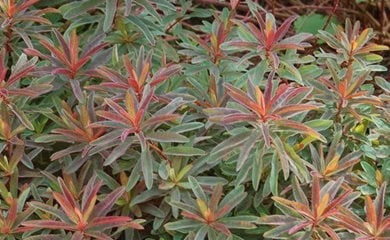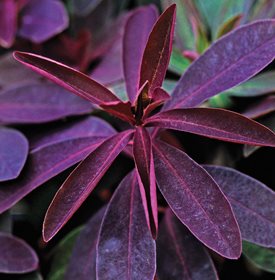Euphorbia: How to Grow & Care for a Spurge Plant
Foliage plants extraordinaire, hardy euphorbias are titans of texture
'Bonfire' cushion spurge (Euphorbia polyanthemus). Photo by Proven Winners.
- Common name: Spurge
- Type: Perennial
- Zones: Ranging 4-10; evergreen in southerly zones
- Exposure: Full sun to partial shade
- Soil: Well-draining
- Warning: Sap is a strong irritant
Euphorbias are easy to grow perennial plants that are tough and have few problems. Popular for their richly colored leaves and unusual flowers, euphorbias are an excellent addition to borders, rock gardens, meadows and more. With over 2,000 types, you’re sure to find one that will thrive in your garden, no matter your zone.
Growing Euphorbia
Why Grow Euphorbia?
- Deer resistant
- Drought and heat tolerant
- Long blooming
- Low maintenance
Euphorbia Care:
Some are short-lived (even so, totally worth growing) and should be divided or propagated every two to three years, either in early fall or spring.
Many benefit from being cut back hard, at least by one-third, after flowering is finished. This keeps any free-seeders from gaining the upper hand and encourages a flush of new fresh foliage.
How to prune euphorbia:
- Trim back any damaged stems in early spring to keep the plant tidy and heathy
- Cut back euphorbia stems at the base immediately after bloom
- Clip carefully, new shoots will likely be emerging that you want to keep in tact
Wear gloves when handling euphorbias, and quickly wash off any milky sap that gets on your skin, as it’s a strong irritant. The sap also makes spurges poisonous, so be aware if you have children and pets, though I’ve had euphorbias and garden cats coexist for years without incident — perhaps the plants’ skunky smell keeps them from seeming like a tasty treat.
Zones:
Perennial euphorbias vary in hardiness, particularly as concerns their northern edges, so check individual entries for the plants covered here. Some types are evergreen in southerly zones but are only root hardy farther north. Other types are best grown as annuals.
Exposure: Sun or Shade?
Euphorbias in general are sun lovers, though some will tolerate partial shade. Those with deep-purple or reddish foliage will have more-intense coloring if planted in full sun. A very few types actually prefer at least dappled shade, while others can thrive in bright sun in the North but need part shade in the blinding light of the South. Euphorbia amygdaloides var. robbiae is a popular choice that grows well in shade.
Soil:
One of the main benefits of growing spurges is their drought tolerance, so good drainage is key, though a few, such as E. griffithii ‘Dixter’ and E. dulcis ‘Chameleon’, do prefer more moisture than others. Euphorbias are also not picky about soils, and most can handle sandy and average situations. For those types that tend to run and spread, fertile soils could encourage them to expand beyond their boundaries, so keeping things lean lends control. But if you want your E. amygdaloides var. robbiae to cover more ground faster, rich organic soil will kick things off.
Euphorbia Plant Varieties
Their lyrical Latin name (euphorbia) and guttural common name (spurge) are indicative of the dual nature of euphorbias — elegant yet tough. The ones discussed here are the hardy perennial types, but the genus also includes succulents like pencil cactus, tropicals like poinsettia and shrubs with wicked-sharp spines.
Hardy spurges have become hugely popular in perennial borders across the continent and in Europe, their stout mounds of leafy stems, like so many oversize bottlebrushes, filling a shrubby role, though with predictable sizes and tidy forms. Newer varieties have richly colored leaves and flower heads, in burgundy, copper, creamy-white striped, eggplant purple and icy blue-green.
The flowers are an unusual arrangement and one of the commonalities of the euphorbia family. Most obvious in the flashy display of poinsettias, the showy parts are actually not flowers but modified leaves called bracts. The real blooms are tiny and distinctly non-flowery looking. One benefit of having bracts is that the floral heads continue to be showy long after the flowers themselves have done their thing. Another common factor among euphorbias is the milky sap that runs through their veins, which is poisonous and a skin irritant. But what makes them toxic also makes them deer resistant—a big bonus. Add to that drought and heat tolerant, long blooming and low maintenance, and you’ve got a nonpareil perennial.
TRY THE UNIQUE DIAMOND® SERIES EUPHORBIAS
While most euphorbias are perennial, the Diamond® series are hybrid annuals that produce airy clouds of tiny white flower bracts above the attractive green lance-shaped foliage. This unique, award-winning variety, which reaches 12 to 18 inches tall and wide, blooms nonstop from planting until frost.
Diamond® euphorbias are tough and virtually maintenance-free, are heat and drought tolerant, and thrive in sun to partial shade. These versatile plants combine well with many other annuals. Use as a filler element in containers, for hanging baskets and window boxes, massed as a bedding plant, or to edge pathways and borders.
Varieties include Diamond Frost® (pictured), Diamond Mountain® and Diamond Snow®.
RELATED:
Foliage Plants
Poisonous Plants













